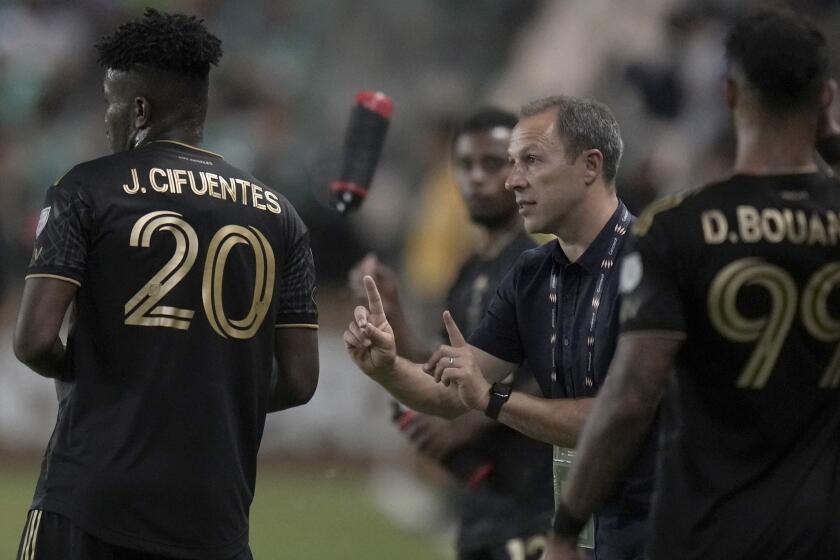How Sandberg got here nearly as classic as career
- Share via
Former Tribune baseball writer Jerome Holtzman’s column the day after Ryne Sandberg Day at Wrigley Field in 1997.
Now that the moment is approaching to say goodbye to Ryne Sandberg, it’s probably a good time to try to explain how he came to the Cubs and why. There is more to the story than the agate line--”Traded to the Cubs with shortstop Larry Bowa, Jan. 27, 1982, from Philadelphia for shortstop Ivan DeJesus.”
The Phillies had acquired Sandberg in June 1978 in the annual summer draft of amateur free agents. He spent his first three full seasons in the minors. In ‘81, at Oklahoma City, the Phillies’ top farm club, he was the American Association’s All-Star shortstop.
Obviously a promising prospect, he was a September callup and finished the season with the Phillies. Aware he needed more experience, the Philadelphia brass recommended he play winter ball in Venezuela.
Bobby Wine, then a Philadelphia coach, also was dispatched to Venezuela. A former big-league infielder, Wine would manage the club and watch over Sandberg, along with four or five other Phillies farmhands.
“He wasn’t too happy about playing winter ball,” recalled Wine, now an advance scout for the Atlanta Braves. “He wanted to go home. A lot of guys wanted to go home. He struggled and didn’t play that well.”
When Wine returned to Philadelphia, he was convinced Sandberg wouldn’t be a successful major-league shortstop. Ruben Amaro, the general manager at Venezuela, who also had been a big-league shortstop, agreed.
“That’s when the Phillies decided to move him,” Wine said.
Three months earlier, on Oct. 15, 1981, Andrew J. McKenna, the newly appointed chairman and president of the Cubs, hired Dallas Green as general manager. A mediocre pitcher, Green was a baseball lifer: 24 years with the Phillies, mostly as the director of player personnel.
At about this time, Bill Giles, the Phillies’ part-owner and club president, told General Manager Paul Owens to trade Bowa, a veteran shortstop.
Owens called Green in Chicago. They were old friends. Green had been his understudy in Philadelphia before he managed the Phillies to the World Series title in 1980. Owens, or perhaps it was Green, proposed a deal: Bowa for DeJesus, who was seven years younger and a capable shortstop.
The rest of the story is open to debate. Green, who knew all the players in the Phillies’ system, held out for Sandberg. Owens agreed and threw Sandberg into the deal. Sandberg blossomed into a star in 1984 when he was named the National League’s most valuable player.
The belief then, which was uncontested, was that Sandberg, not Bowa, was the player Green wanted. To this day, Green is largely credited for swinging one of the best deals in Cubs history.
But there is another version. Some insiders insist that the extra player Green was after was Luis Aguayo, a slick-fielding shortstop who was being groomed as Bowa’s successor. At that time, Aguayo had a much higher profile than Sandberg and was regarded as a “sure-fire” prospect.
Green asked for Aguayo. Giles and Owens refused to part with Aguayo. Green then settled on Sandberg.
Whatever, it turned out to be a master stroke. Aguayo never lived up to his notices. He had a modest 10-year big-league career and played in 568 games, an average of 57 games a year.
Initially, Sandberg was not a smash. Playing third base his first year in Chicago, he batted .271 with seven homers. He followed that with .261 and eight homers while playing second the next year. He won his first Gold Glove and since has been baseball’s premier second baseman.
It was Jim Frey in ‘84, then in his first season as the Cubs’ manager, who turned Sandberg into a power hitter. After watching Sandberg in spring training, Frey told him he was strong enough to swing for the long ball.
“I hit nothing but ground balls. That’s what I did the first two years,” Sandberg recalled at Wrigley Field on Friday.
Only a minor adjustment was needed. Frey told him to turn on the ball.
“He told me when I was ahead on the count, I should try and hit foul balls down the third base line,” he said.
It worked. He hit a home run in the second game of the season, in San Francisco. No. 2 came in San Diego two nights later. The rest of the story is uncontested.
More to Read
Go beyond the scoreboard
Get the latest on L.A.'s teams in the daily Sports Report newsletter.
You may occasionally receive promotional content from the Los Angeles Times.










